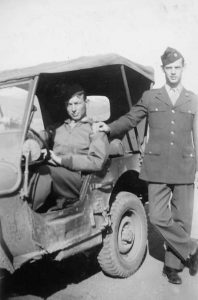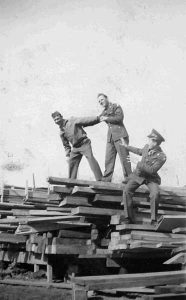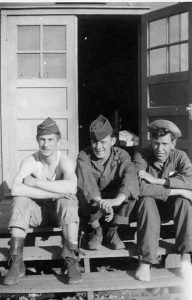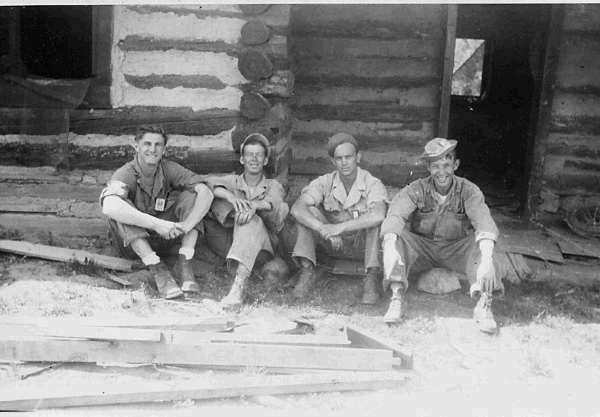In addition to fighting abroad on the battlefield, many members of the U.S. Army served their country on the homefront. Working on the Manhattan Project was one of the ways that soldiers participated in the war effort on American soil. Directed by General Leslie R. Groves, the Manhattan Project was a massive collaborative effort between the U.S. government, the Army, and the industrial and scientific sectors to build the atomic bomb.
Many GIs with scientific and technical backgrounds were recruited for the Special Engineer Detachment. The roles of other GIs during the Manhattan Project, however, are less well known. One often-overlooked unit is the Provisional Engineer Detachment (PED). Members of the PED played an integral part in the construction, operation, and maintenance of the “Secret City” of Los Alamos, New Mexico.
Provisional Engineer Detachment at Los Alamos
In April 1943, three troop units were initially assigned to Los Alamos. These units were the Military Police Detachment, the Provisional Engineer Detachment (PED) and the Provisional Women’s Army Corps (WAC) Detachment. The PED unit was led by 1st Lieutenant Clinton A. Nash and included forty-two enlisted men.
 The PEDs lived with the other military units within a fenced-in section between the Post Headquarters and the main site (Truslow, 105). In this way, the units and construction workers were kept apart from civilians living in Los Alamos. While civilians were able to enter the military area past 6:00 pm, military personnel and construction workers were not allowed to enter the general civilian area without an invitation. The PEDs ate garrison rations from the quartermaster at Bruns General Hospital in Santa Fe, NM.
The PEDs lived with the other military units within a fenced-in section between the Post Headquarters and the main site (Truslow, 105). In this way, the units and construction workers were kept apart from civilians living in Los Alamos. While civilians were able to enter the military area past 6:00 pm, military personnel and construction workers were not allowed to enter the general civilian area without an invitation. The PEDs ate garrison rations from the quartermaster at Bruns General Hospital in Santa Fe, NM.
As a part of the 4817th Service Command Unit in the 8th Service Command Detachment, the PEDs filled specific service jobs around Los Alamos. According to the Los Alamos National Laboratory’s Manhattan Project History: Nonscientific Aspects of Los Alamos Project Y, 1942 through 1946, these jobs included operation of power and steam plants, the motor pool and garage, and mess halls. Some PEDs also performed maintenance and repair of buildings and roads.
As Los Alamos continued to expand during the war and faced a shortage of labor, the PED increased to 256 men. Second Lieutenant Theodore F. Huene became the PED’s second officer. The unit grew again to 465 men as the number of motor vehicles at Los Alamos increased and more mess halls, larger power and steam plants, and a small sawmill were built.
PEDs were also involved in the construction of scientific sites. Some PEDs were a part of construction crews led by Major Wilber A. Stevens that completed work on a number of essential Los Alamos test areas. For example, these crews built a facility for casting containers for explosive charges at Anchor Ranch and constructed many buildings at S-Site, such as a laboratory, shops, powder magazines, and a mess hall.
A continued labor shortage in Los Alamos led to the transfer of some civilian jobs to the PED. A few of these jobs included employment at the commissary, Post Exchange, and post engineer office. According to Vincent C. Jones’s Manhattan: The Army and the Atomic Bomb, PEDs also were assigned to become firefighters in order to avoid recruiting more labor and building new civilian housing.
PEDs and Recreation at Los Alamos
 In his interview on the Voices of the Manhattan Project website, Bob Porton described his time as an PED and later transfer to the Special Engineer Detachment (SED). Arriving in Los Alamos in November 1944, Porton worked as a PED in the recreation department. When he first arrived, his lieutenant tried to convince him to work in supply rather than recreation. Porton, however, recalled telling his lieutenant, “‘I appreciate your consideration and all of that, but recreation sounds very interesting to me.’ I had always been a sports fan. When I found out that they had a little radio station – radio had always fascinated me – I felt it would be a lot more pleasant and more diversified.”
In his interview on the Voices of the Manhattan Project website, Bob Porton described his time as an PED and later transfer to the Special Engineer Detachment (SED). Arriving in Los Alamos in November 1944, Porton worked as a PED in the recreation department. When he first arrived, his lieutenant tried to convince him to work in supply rather than recreation. Porton, however, recalled telling his lieutenant, “‘I appreciate your consideration and all of that, but recreation sounds very interesting to me.’ I had always been a sports fan. When I found out that they had a little radio station – radio had always fascinated me – I felt it would be a lot more pleasant and more diversified.”
In the recreation department, Porton worked under the chaplain, who was the head of recreation, and with fellow PEDs Tom Fike and Caesar Bango. The three PEDs worked in Theater No. 2, an all-purpose building where they held both Saturday night dances and Sunday church services. Porton remembered that the theater was also used to host Army motion picture services, colloquia, and a gymnasium for civilians and military personnel.
Other duties included supplying the ski hill, maintaining the ice skating rink and nine-hole golf course, and running the Los Alamos radio station. Porton noted that they “had forty-five minutes of music at lunch time with Tom and Bob, and it was a request program. People would call in and want to hear the kind of music that was played in those days.”
The station would also have evening programs. Porton and Fike “started a program on the radio station called Music of the Masters. It was classical music and it was for the strict benefit of the scientific personnel. That program went on the station for many, many years.” Given their funding restrictions, Porton recalled that he or Fike “would have to go to the homes of famous scientists and borrow an album of records, and play it on the air that night and return it the next day.”
In July 1945, Porton transferred to the SED. Reflecting on the reassignment, Porton remarked, “Immediately my life changed. SEDs were treated so much better than the other military units.” Unlike the PED and other military units, Porton explained that the SED did not have to do kitchen police (KP) duty, and promotions within the unit were easier to achieve.
PEDs at the Trinity Test
 According to BBC News, Private Daniel A. Yearout was a PED who witnessed the Trinity Test. On July 14, 1945, Yearout and other PEDs left their base for a top-secret mission in Alamogordo, New Mexico. Stationed about eighteen miles from “Ground Zero” at the Trinity Site, the PEDs were brought to the test to aid in potential evacuations of small communities within the probable fallout path.
According to BBC News, Private Daniel A. Yearout was a PED who witnessed the Trinity Test. On July 14, 1945, Yearout and other PEDs left their base for a top-secret mission in Alamogordo, New Mexico. Stationed about eighteen miles from “Ground Zero” at the Trinity Site, the PEDs were brought to the test to aid in potential evacuations of small communities within the probable fallout path.
Yearout told the BBC, “We were called out the night before. One of the officers told us we were going to take part in some testing. He said that if everything went well, the war would be over in a few days. But, then he said that if it all went wrong, ‘It was each damn man for himself.’”
Yearout recalled witnessing the test: ‘Suddenly, without any sound, the whole world lit up. When I came to my senses, I was lying on the ground with my back to where the light was coming from. I put my hands over my eyes to protect them…I whisked around and looked towards the light. I could hear a rumble and the Earth shook. I saw a big fireball rising in the sky – it looked like it was pouring gasoline out there, all the way around. The fireball was getting bigger and bigger and we just stood and watched.’”
Following the test, radiation readings were conducted and the levels recorded were deemed safe. As a result, the PEDs did not need to evacuate the surrounding communities. “No one was allowed to talk about what we saw,” Yearout remembered. “Anyone who did was shipped out pretty quickly.”
After World War II
Following the end of the war, PEDs continued to work at Los Alamos. At its peak, the PED had about 500 enlisted men. On July 1, 1946, the remaining 302 PEDs were relieved of their duties after the unit was inactivated (Truslow, 105).
While the Provisional Engineer Detachment is relatively little-known, the unit’s work in construction, maintenance and many other tasks was pivotal to the functioning of Los Alamos. Along with their fellow GIs serving in other units, the members of the Provisional Engineer Detachment made important contributions to the success of the Manhattan Project.
For a list of service members in the Provisional Engineer Detachment and the Provisional Women’s Army Corps, please see AHF’s Manhattan Project Veterans Database and filter by “Role.”





